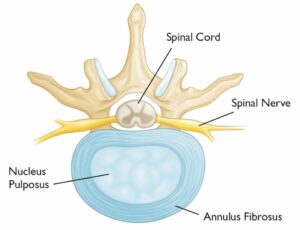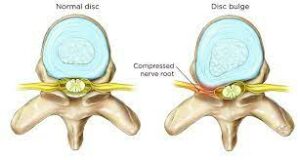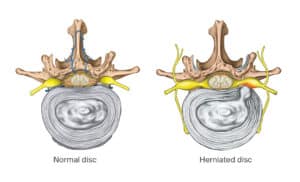The spine contains many bones called vertebrae that run all the way from the neck, into the lower back. Between each bone, there are cartilaginous structures called intervertebral discs.
Intervertebral discs have three parts: the annulus fibrosis, nucleus pulposus, and the vertebral endplates. The annulus fibrosis is the strong, fibrous outer layer of the disc which contains the nucleus pulposus, the gel-like structure on the inside. The vertebral endplate covers the superior and inferior aspects of the intervertebral disc, acting as the main source of nutrition. All of these structures are necessary for the spine to carry out its functions, allowing us to perform our day-to-day tasks.

Intervertebral discs have an array of functions which allow the us to perform our daily tasks. Intervertebral discs are designed to allow for movement between the vertebral bodies, provide stability during weight bearing, absorb shock from the heavy loads and stresses that our spine is placed under, and slowly distribute the force to the vertebrae. When things go wrong with these discs, conditions such as disc bulges and disc herniations can arise that may cause discomfort and pain, interfering with the normal functioning of the spine. The most common regions for these conditions to occur in are the cervical and lumbar regions of the spine. This blog is primarily dedicated towards disc bulges and herniations in the cervical spine, their causes, symptoms and treatments.
What is a disc bulge?
A bulging disc refers to the disc tissues extending beyond the edges of the vertebrae. The annulus fibrosus remains intact, meaning the nucleus pulposus stays inside of the annulus fibrosus.

What is a disc herniation?
A disc herniation refers to the annulus fibrosus becoming weakened or cracked, allowing the nucleus pulposus to protrude out and leak into the surrounding areas. A disc herniation is commonly more severe and likely to cause more pain than a disc bulge.

Causes:
Both disc bulges and herniated discs have similar causes, these can include:
- Degeneration of the intervertebral disc that occurs naturally as we age. Intervertebral discs contain lots of water, and as we age this water content decreases, increasing the likelihood of a disc bulge or herniation.
- Injury or traumatic events such as a sporting injury, car crash, or a fall.
- Large compressive forces that overload the intervertebral disc.
- Repetitive neck movements such as twisting, flexing or extending the neck repetitively without breaks in-between.
Symptoms:
In some individuals, bulging discs may have no symptoms, and can go unnoticed for long periods of time.
For herniated discs and symptomatic cases of bulging discs in the neck, symptoms may include:
- Reduced range of motion of the neck.
- Pain at the site of the disc bulge or herniation.
- Nerve or spinal cord pain that may cause numbness, tingling, weakness or sensory changes in the neck which can extend throughout the upper limb.
Diagnosis and treatment:
Due to the multifaceted nature of neck pain, it is difficult to narrow down the source of pain to a disc bulge or herniation without medical imaging and clinical history. However, physiotherapists can conduct a thorough examination which may identify patterns of dysfunction, suggesting there is an injured intervertebral disc. From there, physiotherapists will be able to provide the necessary treatments.
Your physiotherapist may use manual therapy techniques such as soft tissue releases of the neck which can improve the range of motion of the neck as well as help to reduce or relieve the neck pain associated with your disc bulge or herniation.
They can also provide you with neck strengthening and stretching exercises. The strengthening exercises may help improve the strength of the neck muscles which can reduce the load that is placed on the cervical spine. The stretching exercises may provide some relief from the neck pain that is occurring as a result of the disc bulge or disc herniation.
In conclusion, our spine, and the discs in-between them are vital for our daily living, but there are complications which may impair the normal functioning. If you are experiencing pain, ensure that you seek the appropriate help so you may be able to receive the appropriate treatment to manage your pain and get back to performing your daily activities.

